Comparative Study of Two Daylighting Analysis Methods with Regard to Window Orientation and Interior Wall Reflectance
Abstract
:1. Introduction
1.1. Background and Purpose
1.2. Research Scope
2. Simulation Overview and Theoretical Background
2.1. Simulation Software
2.2. Simulation Modelling
| Input data | 6 mm Clear |
|---|---|
| Solar transmittance | 0.765 |
| Front side solar reflectance | 0.073 |
| Back side solar reflectance | 0.073 |
| Visible transmittance | 0.878 |
| Front side visible reflectance | 0.083 |
| Back side visible reflectance | 0.083 |
| Front side infrared hemispherical emissivity | 0.42 |
| Back side infrared hemispherical emissivity | 0.42 |
| Conductivity (W/mK) | 0.9 |
| Dirt correction factor for solar and visible transmittance | 1 |
| Solar diffusion | No |
2.3. Analysis of Algorithm

- Lw = Luminance for window;
- dΩ = subtended solid angle from window on reference point;
- γ = angle between the line joining reference point and center of (x, y) patch on window and vertical line.

- Ljl = Luminance of internal surface patch “jl”;
- Fik→jl = Form factor or light-weight factor;
- Lcik = directly transmitted luminance from window;
- Nj and N = Number of inside wall surface patch.
- Lw = Luminance for window;
- L = Luminance of sky or obstruction;
- τVIS = visible transmittance of glass at angle B;
- B = angle between line joining reference point and center of (x, y) patch on window and window normal.

- Lcik = directly transmitted luminance from window;
- Fik→jl = purely geometric coefficients called form factor;
- τik−jl = Transmissivity of window between ik patch under consideration and jl patch on window;
- Lp = Luminance of outside surface or sky from which light beam can travel;
- δc = denotes if direct sunshine falls on inside node (δc = 1) or not (δc = 0);
- τik−s = Transmissivity of window between patch ik and patch on sky dome as seen from window;
- Es = direct solar illumination perpendicular to rays;
- βsik = angle between window surface (ik patch) normal and the unit vector pointing towards the sun;
- Nj = Number of outside surface patch;
- Nc + Nsw = Number of clear window and opaque walls on model surface.

- Itot(iL) = Net illuminance at reference point iL;
- is = window shade index (unshaded = 1, shaded = 2);
- Iwin(is, iL) = Interior illuminance at point iL.
- đsun/đsky,k/đsky,k′ = interpolated daylight factors for sun and skies k and k′;
- Eh,sun/Eh,sky = exterior horizontal illuminance from sun and sky;
- fk/fk′ = fraction of horizontal illuminance from sky due to sky type k and k′;
- Snorm,dir = Direct normal solar irradiance;
- Sh,dir = Exterior direct horizontal solar irradiance;
- Z = solar zenith angle;
- ηdir = luminous efficacy of direct radiation from sun;
- ηdif = luminous efficacy of diffuse solar radiation from sky.
3. Analysis
3.1. Analysis of Interior Illuminance for Various Orientation of Window
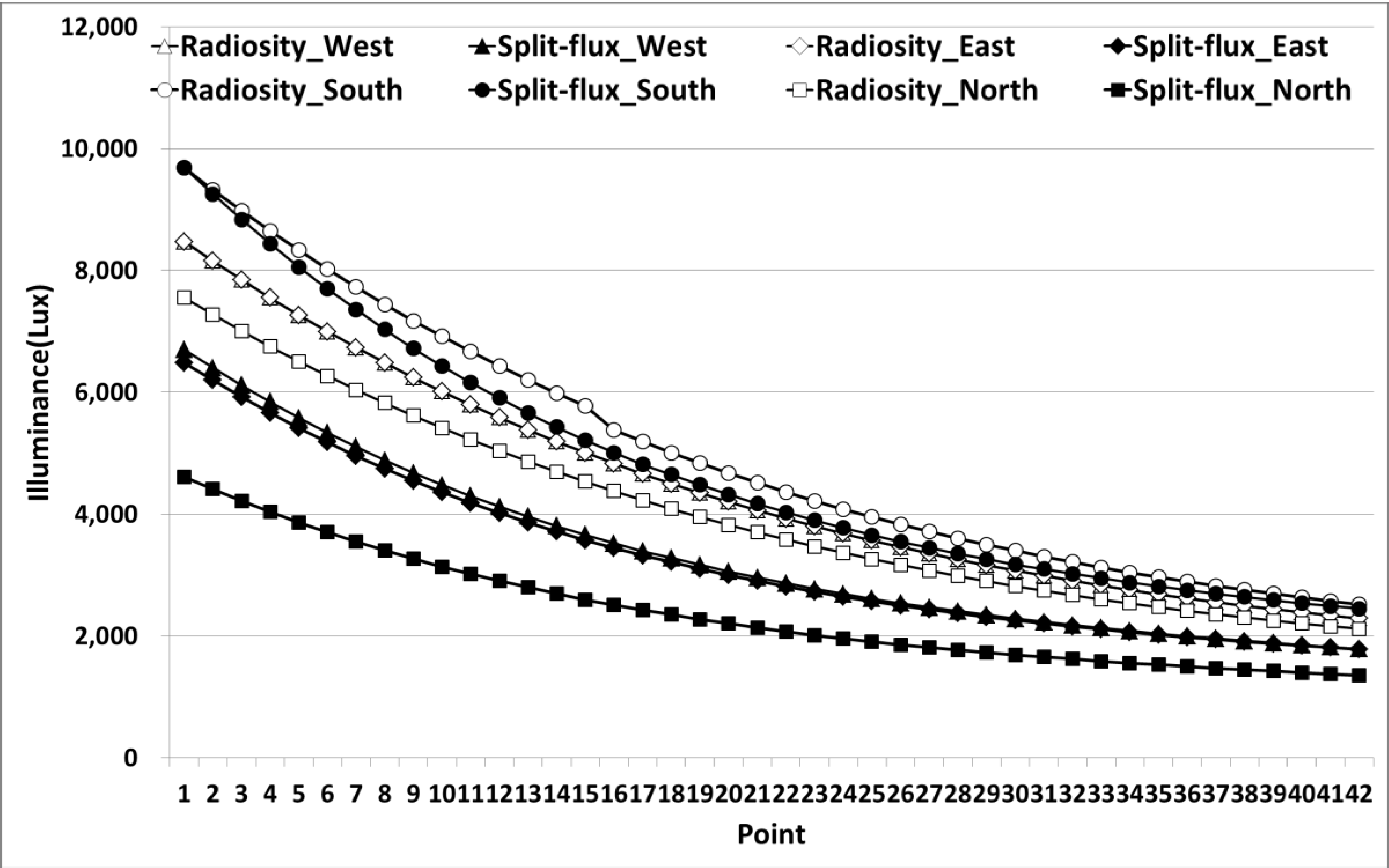
3.2. Analysis of Interior Illuminance at Different Time
3.2.1. Analysis for West Orientation
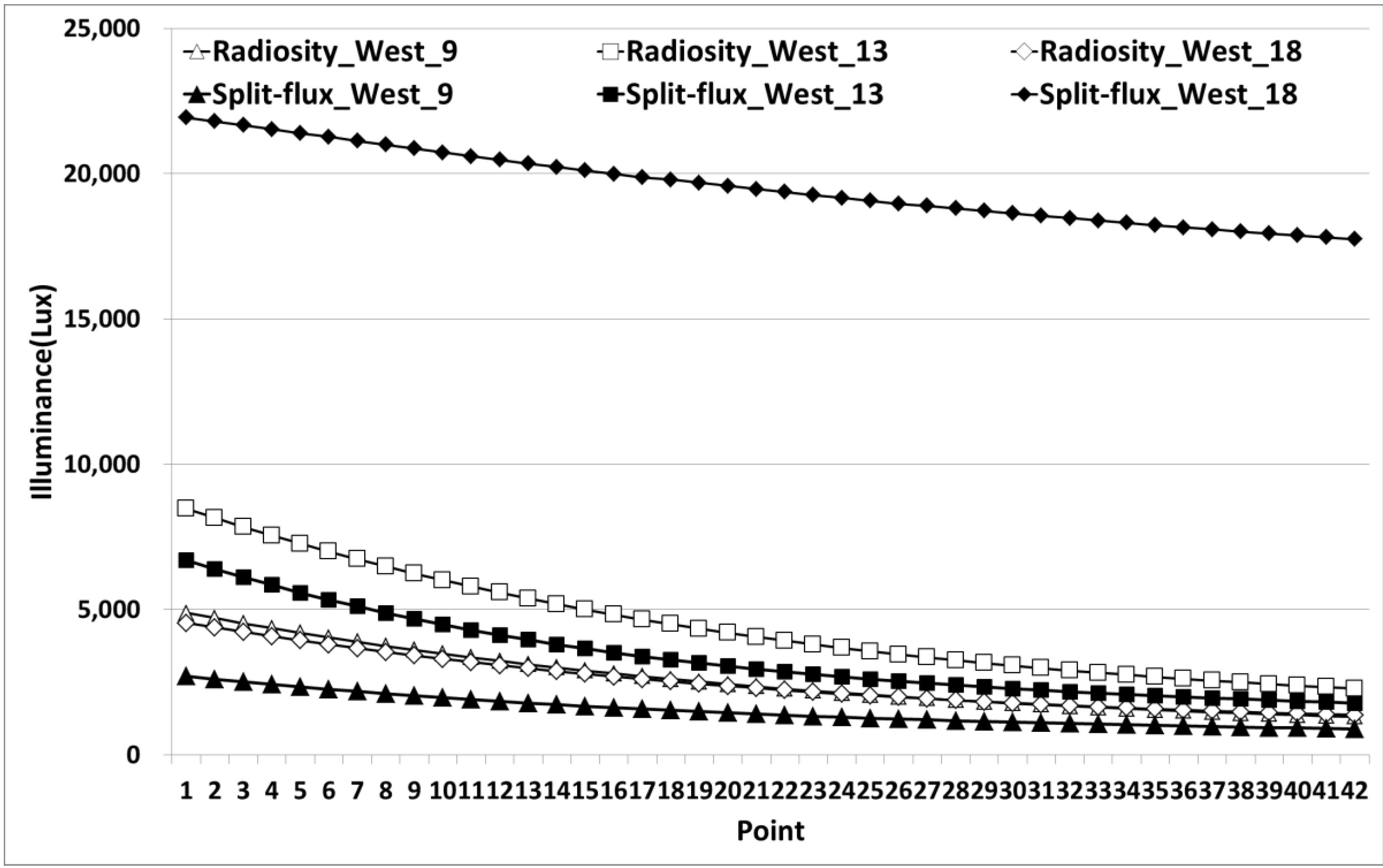
3.2.2. Analysis for South Orientation
3.2.3. Analysis for North Orientation
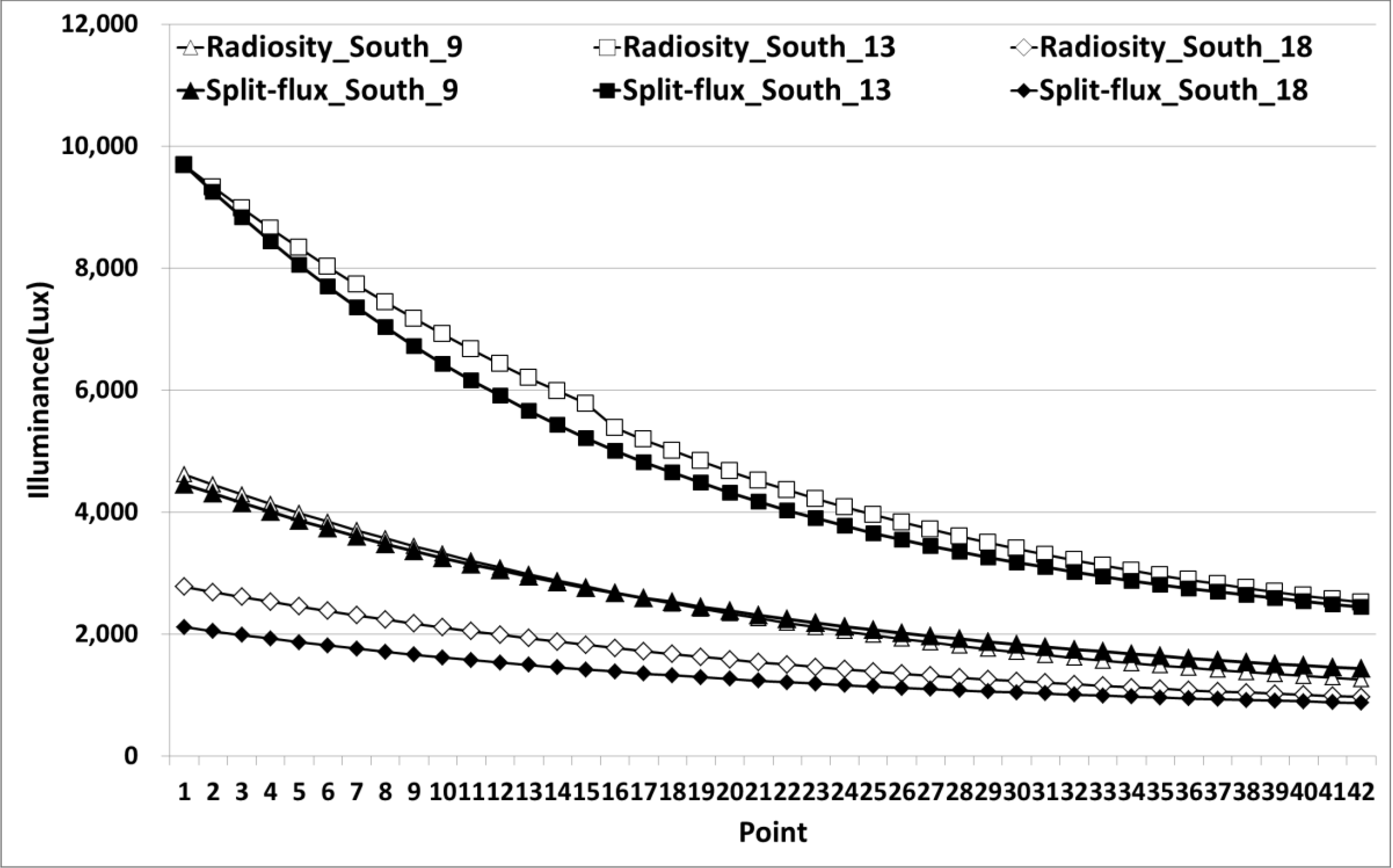
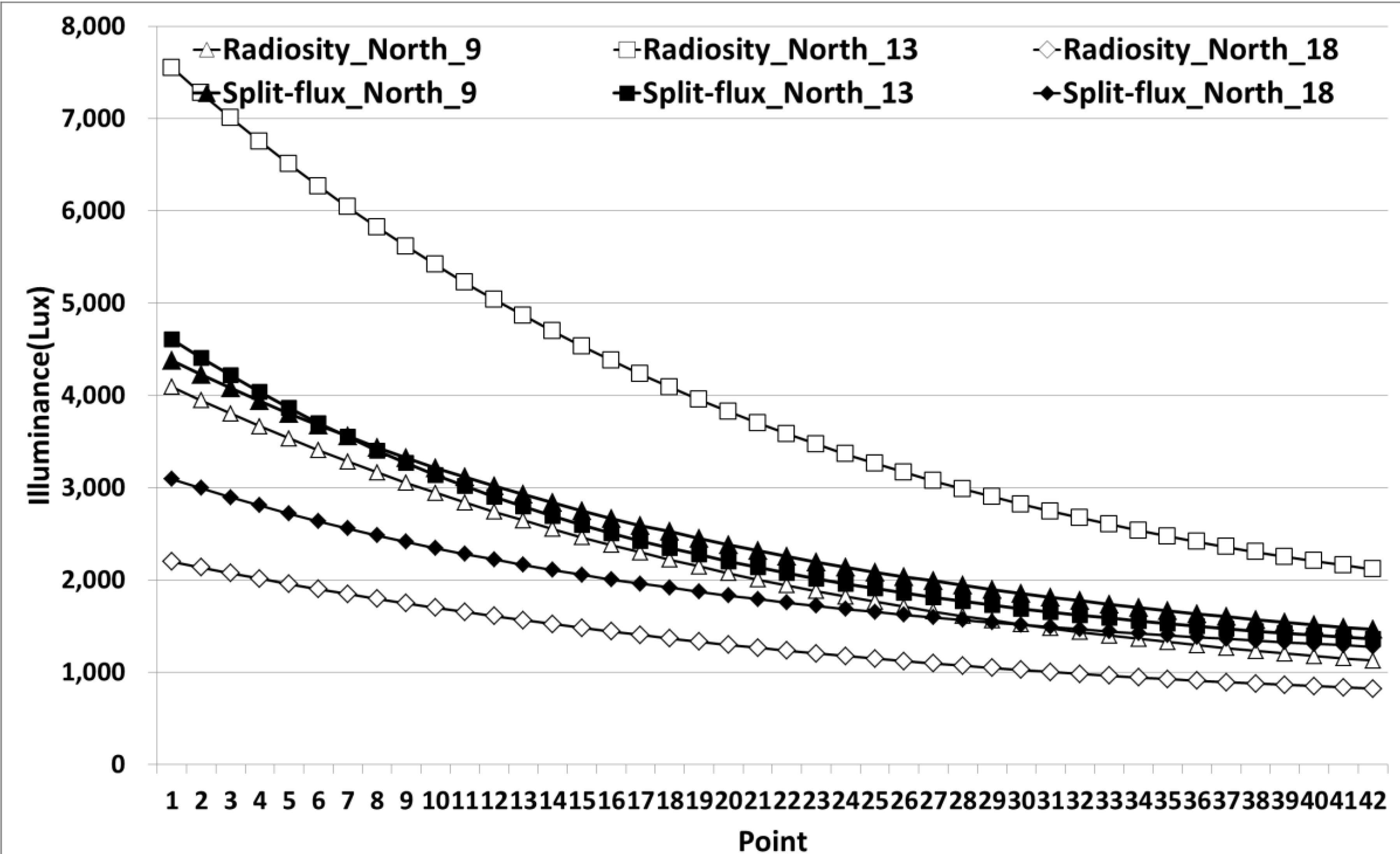
3.3. Analysis of Direct and Diffuse Illumianance
3.3.1. Analysis of Direct and Diffuse Illumianance for West Orientation of Window
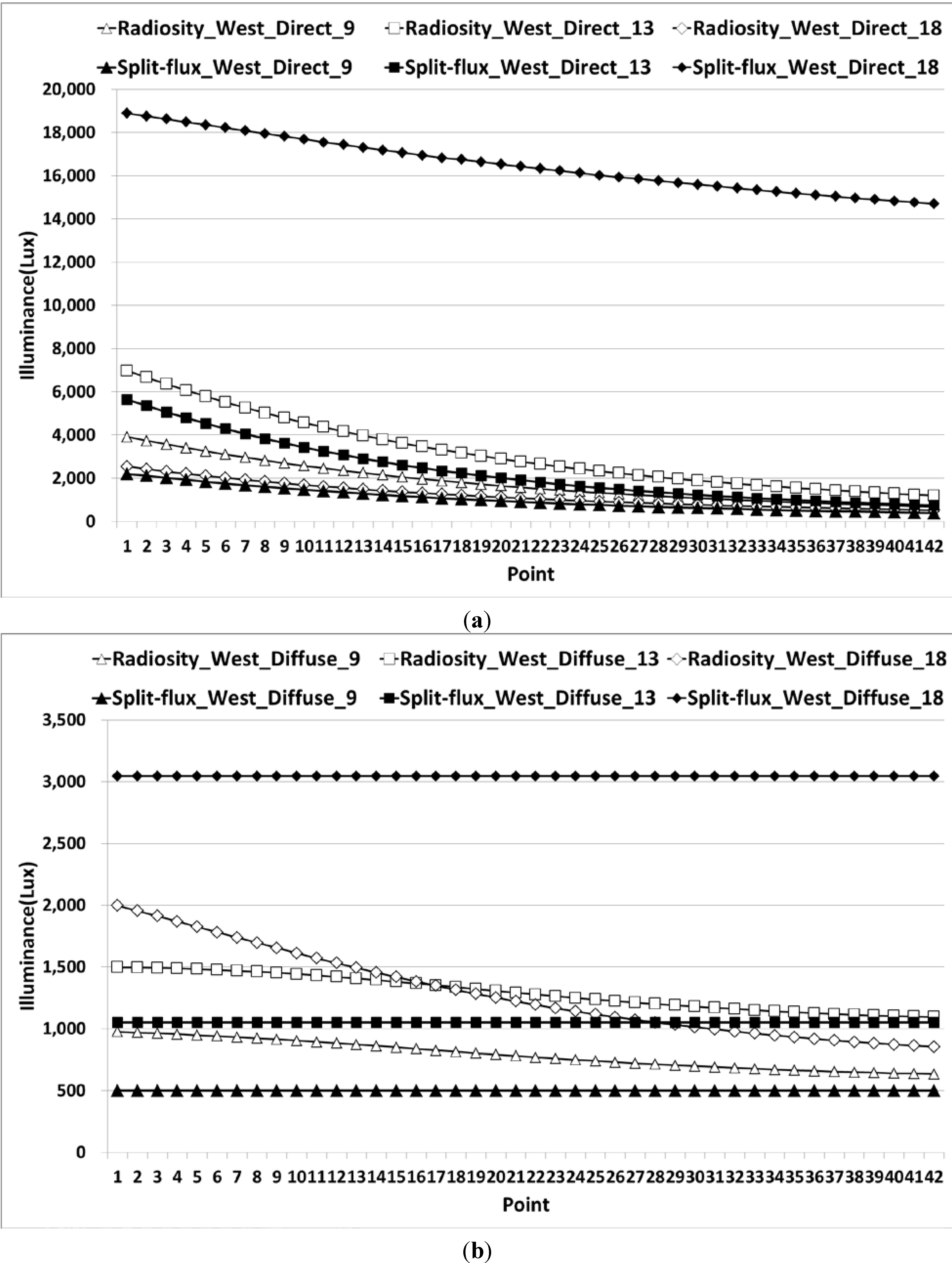
3.3.2. Analysis of Direct and Diffuse Illumianance for South Orientation of Window
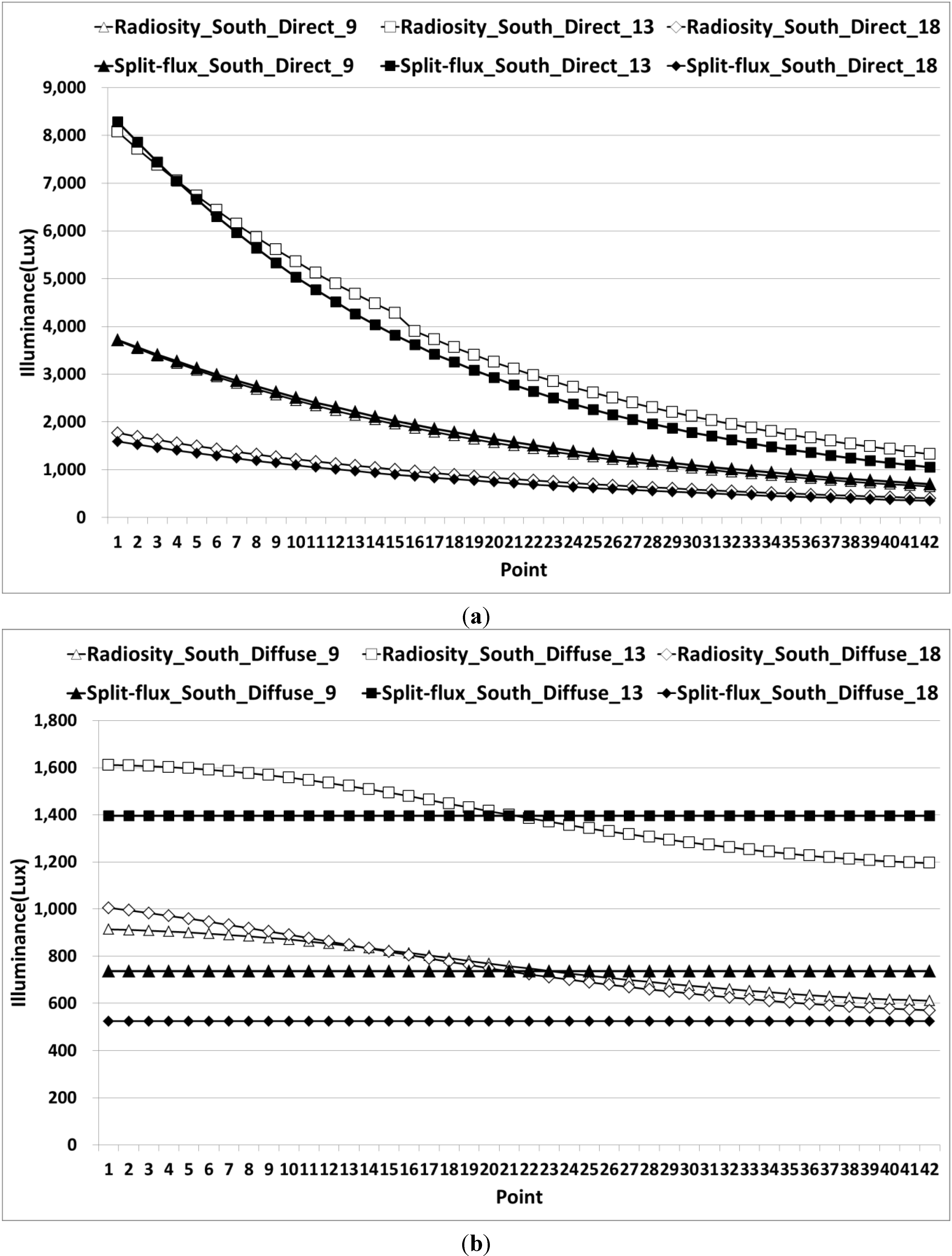
3.4. Analysis of Direct and Diffuse Illuminance Due to Change in Wall Reflectance with South Oriented Window
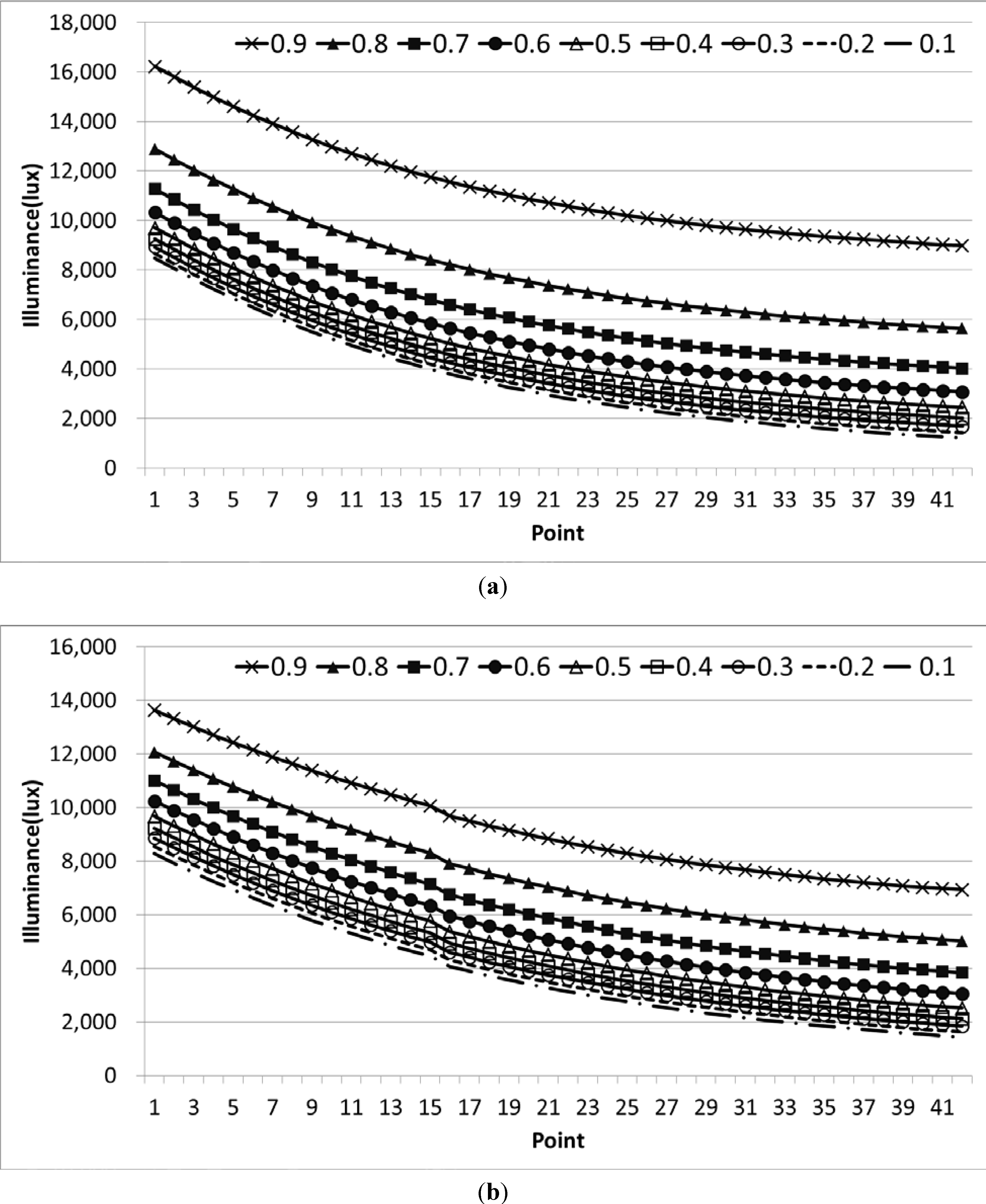

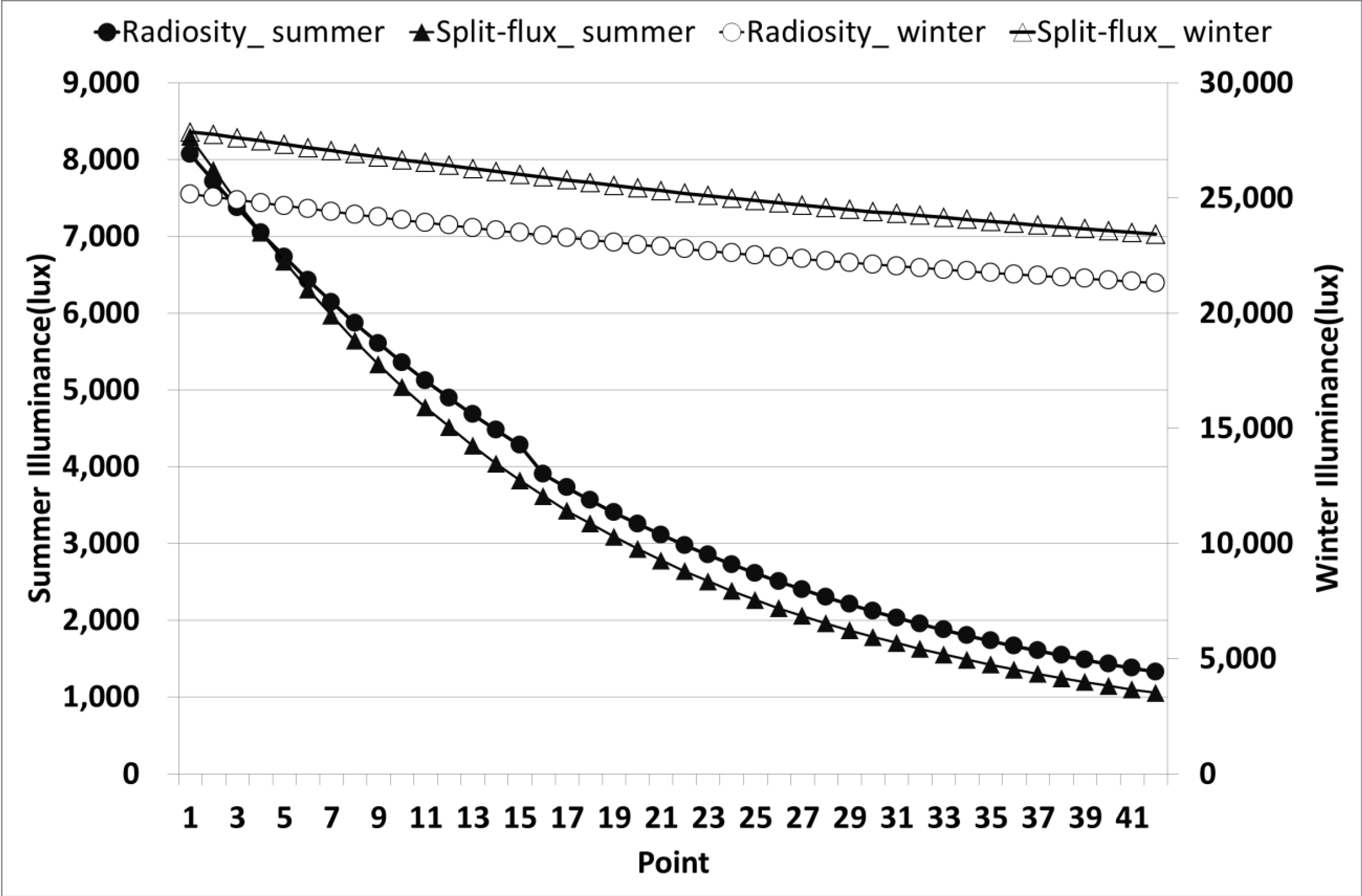
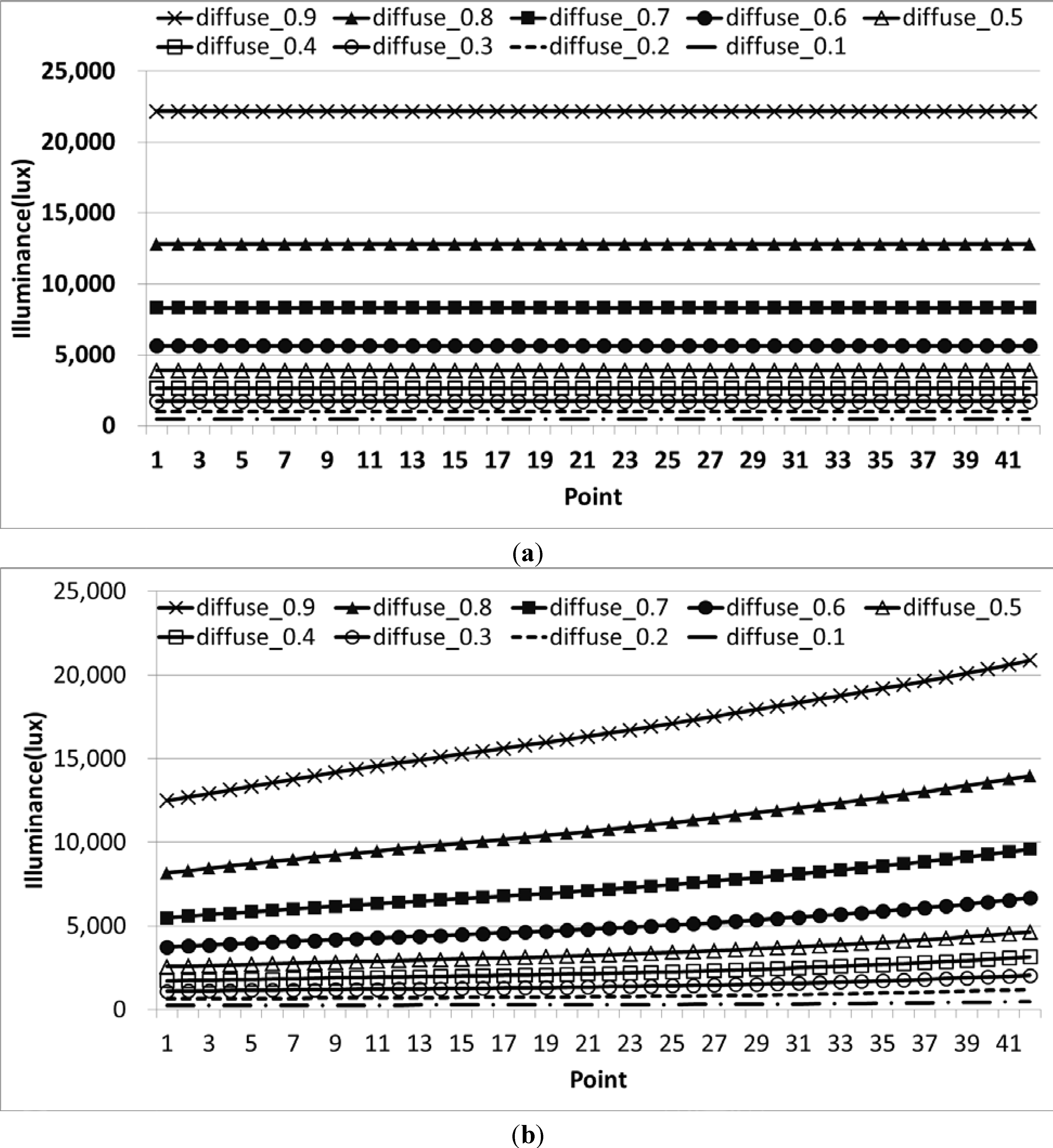

3.5. Result Conclusion from above Simulation Results

4. Conclusions
- The day chosen for simulation is a clear day with high illuminance. For both the Radiosity and Split-flux methods, in case of south orientation, the interior illuminance value is very high and the difference in the data from two methods is not very high. However, in other orientations, the Radiosity value is higher than the Split-flux method. Thus, detailed study was carried out.
- For West orientation, interior illuminance from the Radiosity and Split-flux methods were compared at 09:00, 13:00 and 18:00. In the Split-flux method, the illuminance was highest at 18:00. At 18:00, the solar incidence angle is very low and the window transmitted solar is very high, which is clearly reflected in the Split-flux method. However, in the Radiosity method, this is not the case. This is attributed to the time-step interior illuminance which is dependent only on the interpolated Daylight Factor and the time-step external horizontal illuminance. At 09:00 and 18:00, the pattern is same as for the other data.
- In North and South orientation, the pattern is very similar to the above analysis. At 13:00, the interior illuminance is higher. However, for north orientation, at 09:00 and 18:00, the Split-flux data is more than the Radiosity illuminance data. This is because of how Split-flux and Radiosity algorithm treats diffuse illuminance. For Split-flux, the illuminance value is high and is constant irrespective of the distance from window.
- In the Split-flux method, in every step of the equation, solar angle and the incident angle is incorporated, either directly or indirectly. However, in Radiosity, only the incidence angle is taken in account. By the time the interior illuminance is calculated, the incidence angle is between the interior reflecting surface and reference point. Ultimately, during time-step interior illuminance, it does not make any appearance at all.
- As we move further away from the window, the illuminance level decreases, except for in winter solstice conditions, when sunlight penetrates deeper into the room, and this phenomenon is reversed. Moreover, the illuminance level increases with the increase in wall reflectance. This is because of how the Radiosity algorithm works. As we go further into the room, there is more reflected light and more point to point pairs for the algorithm to work. We also believe that due to the presence of window, the light instead of being re-reflected into the room, bounces out of the window, making the illuminance level lower near window than further inside the room. This becomes more pronounced as the wall reflectance increases. Therefore, the illuminance level increases when wall reflectance and distance from the window increases.
Acknowledgments
Author Contributions
Conflicts of Interest
References
- Koshel, R.J. Illumination engineering. Opt. Eng. 2004, 43, 1478–1479. [Google Scholar] [CrossRef]
- Nakamura, Y. Method of discomfort glare estimation applicable to a wide range of source sizes-glare estimation system based on luminance image. Light Eng. 2008, 16, 84–88. [Google Scholar]
- Carroll, W.L. Daylighting Simulation: Methods, Algorithms, and Resources; Report of IEA SHC Task 21/ECBCS ANNEX 29. No. LBNL-44296; Lawrence Berkeley National Laboratory: Berkeley, CA, USA, 1999. [Google Scholar]
- Dong, J.T.; Lu, R.S.; Shi, Y.Q.; Xia, R.X.; Li, Q.; Xu, Y. Optical design of color light-emitting diode ring light for machine vision inspection. Opt. Eng. 2011, 50, 043001:1–043001:11. [Google Scholar]
- Audenaert, J.; Leloup, F.B.; van Giel, B.; Durinck, G.; Deconinck, G.; Hanselaer, P. Impact of the accurateness of bidirectional reflectance distribution function data on the intensity and luminance distributions of a light-emitting diode mixing chamber as obtained by simulations. Opt. Eng. 2013, 52. [Google Scholar] [CrossRef]
- Tsangrassoulis, A.; Bourdakis, V. Comparison of radiosity and ray-tracing techniques with a practical design procedure for the prediction of daylight levels in atria. Renew. Energy 2003, 28, 2157–2162. [Google Scholar] [CrossRef]
- Hviid, C.A.; Nielsen, T.R.; Svendsen, S. Simple tool to evaluate the impact of daylight on building energy consumption. Sol. Energy 2008, 82, 787–798. [Google Scholar] [CrossRef]
- Versage, R.; Melo, A.P.; Lamberts, R. Impact of different daylighting simulation results on the prediction of total energy consumption. In Proceedings of the SimBuild 2010 Conference, New York, NY, USA, 11–13 August 2010; pp. 1–7.
- Robinson, D.; Stone, A. Internal illumination prediction based on a simplified radiosity algorithm. Sol. Energy 2006, 80, 260–267. [Google Scholar] [CrossRef]
- Robinson, D.; Stone, A. A simplified radiosity algorithm for general urban radiation exchange. Build. Serv. Eng. Res. Technol. 2005, 26, 271–284. [Google Scholar] [CrossRef]
- Tsangrassoulis, A.; Santamouris, M.; Asimakopoulos, D. Theoretical and experimental analysis of daylight performance for various shading systems. Energy Build. 1996, 24, 223–230. [Google Scholar] [CrossRef]
- Yoon, Y.B.; Jeong, W.R.; Lee, K.H. Window material daylighting performance assessment algorithm: Comparing radiosity and split-flux methods. Energies 2014, 7, 2362–2376. [Google Scholar] [CrossRef]
- Winkelmann, F. Modeling windows in EnergyPlus, building simulation 2011. In Proceedings of the 7th International IBPSA Conference, Rio de Janeiro, Brazil, 13–15 August 2001.
- The U.S. DOE. EnergyPlus Engineering Reference. The Reference to EnergyPlus Calculations. Available online: http://apps1.eere.energy.gov/buildings/energyplus/pdfs/engineeringreference.pdf (accessed on 29 October 2012).
- Hitchcock, R.J.; Carroll, W.L. DElight: A Daylighting and Electric Lighting Simulation Engine. In Proceedings of the 8th International IBPSA Conference, Eindhoven, the Netherlands, 11–14 August 2003; pp. 483–489.
- Modest, M.F. A general model for the calculation of daylighting in interior spaces. Energy Build. 1982, 5, 69–79. [Google Scholar] [CrossRef]
- Crawley, D.B.; Lawrie, L.K.; Winkelmann, F.C.; Buhl, W.F.; Pedersen, C.O.; Strand, R.K.; Liesen, R.J.; Fisher, D.E.; Witte, M.J.; Henninger, R.H.; et al. EnergyPlus: New, capable, and linked. In Proceedings of the Performance of Exterior Envelopes of Whole Buildings VIII, ASHRAE 2001, Clearwater Beach, FL, USA, 1–5 December 2001.
- Jeong, W.R. Visual Environment Assessment of Office Space Daylighted by Transparent BIPV Window System. Master’s Thesis, Hanbat National University, Daejeon, Korea, 2013. [Google Scholar]
- The U.S. DOE. EnergyPlus Input Output Reference: The Encyclopedic Reference to EnergyPlus Input and Output. Available online: http://apps1.eere.energy.gov/buildings/energyplus/pdfs/inputoutputreference.pdf (accessed on 29 October 2013).
- The U.S. DOE. Tips & Tricks for Using EnergyPlus; Insider Secrets to Using EnergyPlus. Available online: http://apps1.eere.energy.gov/buildings/energyplus/pdfs/tips_and_tricks_using_energyplus.pdf (accessed on 28 February 2014).
- Yoon, Y.B.; Lee, K.H. Comparing Radiosity and Split-flux illuminance algorithm in Energyplus. In Proceedings of the Biannual Autumn Conference of Korean Institute of Architectural Sustainable Environment and Building System (KIAEBS), Seoul, Korea, 2 November 2013.
- Modest, M.F. Daylighting Calculations for Non-Rectangular Interior Spaces with Shading Devices. Report No. LBL-12599; Lawrence Berkeley Laboratory: Berkeley, CA, USA, 1981. [Google Scholar]
- Müller, S.; Kresse, W.; Gatenby, N.; Schöffel, F. A radiosity approach for the simulation of daylight. In Rendering Techniques ’95 Eurographics. Proceedings of the Eurographics Workshop, Dublin, Ireland, 12–14 June 1995.
- Willmott, A.J.; Heckbert, P.S. An Empirical Comparison of Radiosity Algorithms; Technical Report CMU-CS-97-115; School of Computer Science, Carnegie Mellon University: Pittsburgh, PA, USA, 1997; pp. 7–10. [Google Scholar]
- Winkelmann, F.C. Daylighting Calculation in DOE-2; Report No. LBL-11353; Lawrence Berkeley Laboratory: Berkeley, CA, USA, 1983. [Google Scholar]
- Winkelmann, F.C. Daylighting Simulation in the DOE-2 Building Energy Analysis Program; Report No. LBL-18508; Lawrence Berkeley Laboratory: Berkeley, CA, USA, 1985. [Google Scholar]
© 2014 by the authors; licensee MDPI, Basel, Switzerland. This article is an open access article distributed under the terms and conditions of the Creative Commons Attribution license (http://creativecommons.org/licenses/by/3.0/).
Share and Cite
Yoon, Y.B.; Manandhar, R.; Lee, K.H. Comparative Study of Two Daylighting Analysis Methods with Regard to Window Orientation and Interior Wall Reflectance. Energies 2014, 7, 5825-5846. https://doi.org/10.3390/en7095825
Yoon YB, Manandhar R, Lee KH. Comparative Study of Two Daylighting Analysis Methods with Regard to Window Orientation and Interior Wall Reflectance. Energies. 2014; 7(9):5825-5846. https://doi.org/10.3390/en7095825
Chicago/Turabian StyleYoon, Yeo Beom, Rashmi Manandhar, and Kwang Ho Lee. 2014. "Comparative Study of Two Daylighting Analysis Methods with Regard to Window Orientation and Interior Wall Reflectance" Energies 7, no. 9: 5825-5846. https://doi.org/10.3390/en7095825




